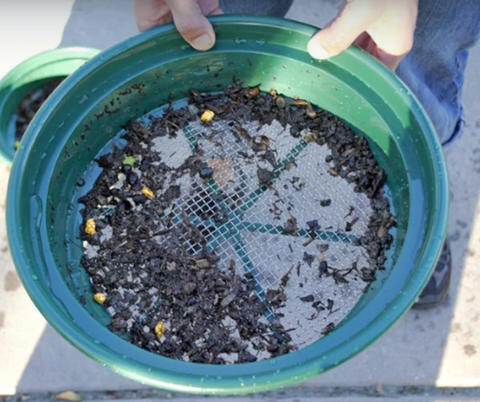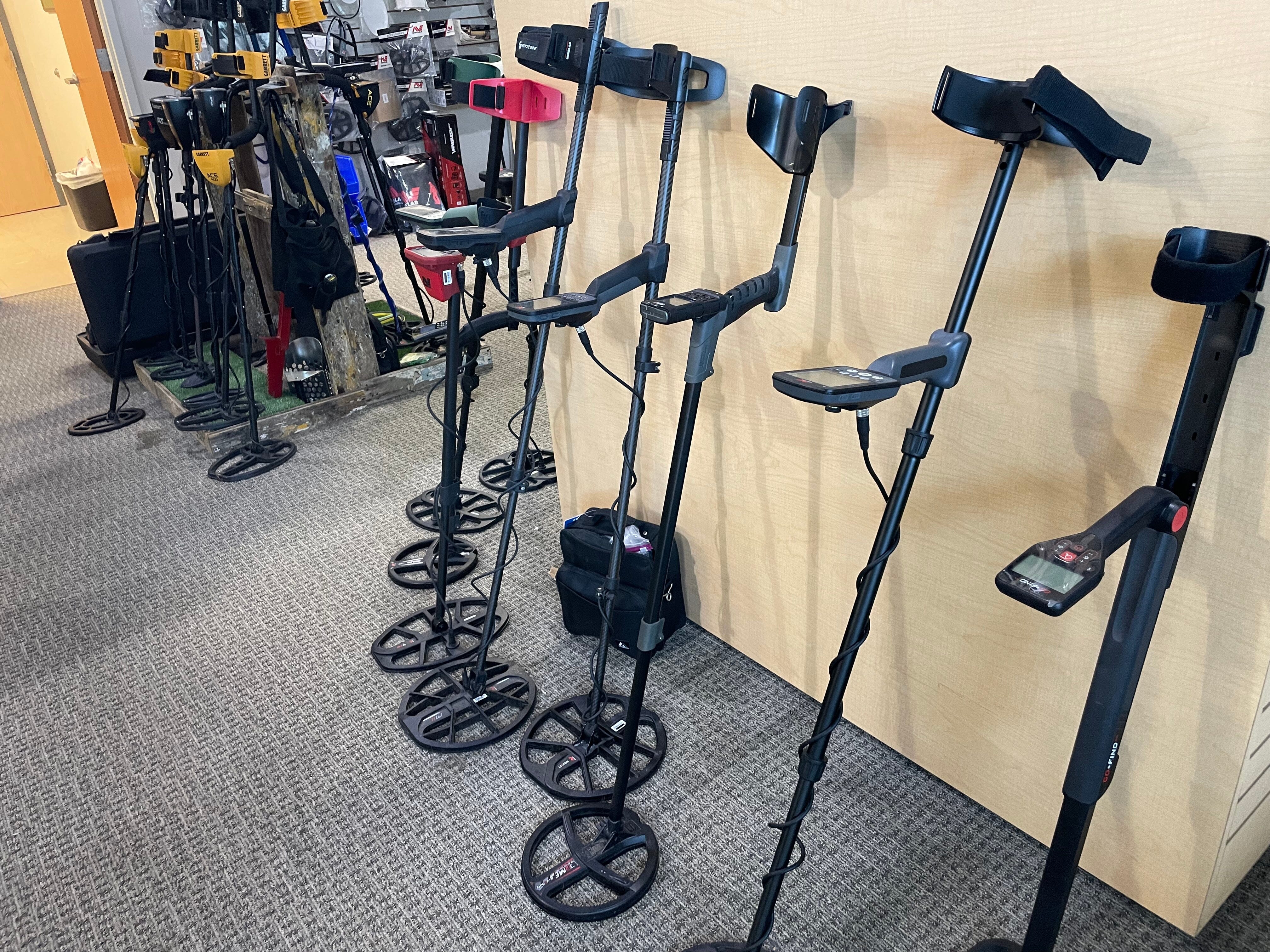Menu
Classification of Material is Key to Optimal Gold Recovery
Why is sifting or classifying gold bearing material so important for optimal gold recovery?
Sifting gold bearing material is referred to as "Classification". Classification is an essential step in efficient recovery of gold.
First, it is very important to try to filter out any unnecessary material prior to running it through a sluice box, highbanker, or any other equipment you may be using to process your gold bearing material. Plant debris can clog up pumps rather quickly and can also make a mess of your water. Also, unless you are in an area known for nuggets, then why would you want to run nugget size material through a sluice box...or even a gold pan for that matter. You would simply be wasting time and effort lugging around big material that won't have any gold. Additionally, gold prospecting equipment works best when the material you are running is similar in size due to "specific gravity".
What is specific gravity and why is it important in gold prospecting or mining?
One very important concept to understand is specific gravity. We don't want to get too geeky but wfactors. hen it comes to recovering gold, it is one of the most important.

In layman's terms, let's say you are gold panning and just placed a scoop of gold bearing material in your gold pan with water. As you shake that pan up (also known as stratifying it) water will be dispersed pretty evenly through your material. This creates a "slurry" also known as an amalgamation ( I know, I said we wouldn't get too geeky, but there is a little science behind optimal gold recovery). This will allow heavier items will naturally sink to the bottom of your amalgamation. Think about it. A piece of gold say, the size of a small "picker" sized nugget may weigh the same size of a rock ten times its size. By stratification, we mean that the items will sink to a layer of material it's specific weight...not it's size. Thus, by sorting out larger "overburden" you will find that you will have higher concentrations of gold and better gold recovery rates.
Gold weighs a lot more than the granite and other stones that often fill your bucket. By classifying material into an equivalent size, you will maximize the effectiveness of the equipment used to process the material.
The Anatomy of a Gold Classifier/Sifter
Gold classifiers come in many different shapes and sizes. The most common classifiers fit nicely into a typical 5-gallong bucket and most often will nest into one another so you can classify the same material into several different sizes at once. They can be referred to as a sifting pan and they typically have a ring around the edge that gives them enough depth to hold a fair amount of material and provide a place for you to hold and shake. They normally have a mesh on the bottom that can be stainless steel wire or plastic which allows smaller material to be filtered out.
Stacking Classifiers in Action
What does the "mesh" size of a gold classifier mean?
Classifiers come in many different sizes or “mesh”. These meshes are usually measured in fractions of an inch. Meshes smaller than one eighth of an inch are often referred to differently. For example, mesh that blocks material larger than one twentieth of an inch is referred to as “twenty mesh” or 20#. Mesh that blocks material larger than one fiftieth of an inch is called 50 mesh or 50#, etc. High Plains Prospectors stocks gold classifiers in sizes from one half inch to 100 mesh.
If you are in an area that has historically never produced any gold over 1/8" in diameter, what is the purpose of running that material through a sluice box? Your gold recovery rate would drastically improve and your wasted effort would decrease by classifying all of your material down to below 1/8" prior to processing it. If you are in an area known for only fine gold, you may want to classify it down to a 20#. Don't feel like you are wasting anything by sifting out the larger material...there is nothing wrong with running it later, in a separate run, with material of its size to see if you can be the guy to find the big gold. But it is important to run material of a similar size regardless of that size.
Classifiers for gold prospecting and gem hunting come in several shapes and sizes to help classify paydirt into a size that is easier to process. Our most popular classifiers are 14” across and fit on top of a five-gallon bucket. This allows one person to shovel paydirt onto the classifier and the other person to shake it down to size. The classifier allows the smaller paydirt to fall into the bucket for further processing while blocking the larger material that could clog fine gold recovery tools. When using a classifier, be sure to always check the material before discarding so you don’t throw out any monster nuggets or huge gems! Two people can fill several five-gallon buckets with classified paydirt in a brief period of time which means you can move more dirt and find more gold or gems.
It's good to know the size of the gold in your area when you’re trying to decide on the right size classifier for the material you’re going to process. If there are nuggets up to a half inch in diameter in the area, you’d want to start with a half inch classifier. Be sure to look through the material left behind before discarding it. You don't want to throw away a fortune. If most of the gold recovered in the area is known to be small flakes or flour gold, you’ll want to classify the material down a lot finer before sending it through your plant. Be sure to test-pan your material to see what size gold you’re generally working with.
Different Classifier Sizes and Types
Bucket Classifiers
Bucket classifiers allow you to place a classifier on top of a 5-gallon bucket and shovel dirt into it with a standard spade shovel. Typically you can buy these classifiers individually or in a set.
Miniature Classifiers
Although large gold classifiers are great for moving more dirt quicker but sometimes a smaller classifier is better for using when sampling, working in your garage, or for gold clean up. They typically come in similar mesh sizes and can also be purchased in a set or individually.
Plastic Classifiers
Plastic gold classifiers are typically cheaper than their stainless steel counterparts and do not offer too many mesh sizes due to manufacturing and material limitations. They are light weight and cheap and do the job needed. These can also be used when metal detecting so they do not interfere with the metal detector.
You would be surprised at how many classifiers we sell for various other reason. For instance they make great gardening tools to sift our rocks, roots, and such. They can also be used to sort tumbling medium when polishing bullet casings.
Regardless of what you use to run your paydirt, whether you use a highbanker, trommel, spiral wheel or a ground sluice, an important step is to classify the material. Classifying down your material makes it easier for your plant to catch the gold you’re hunting.
You Might Be Interested In

Coin & Relic Cleaning Supplies
Pair text with an image to focus on your chosen product, collection, or blog post. Add details on availability, style, or even provide a review.
- Choosing a selection results in a full page refresh.
















